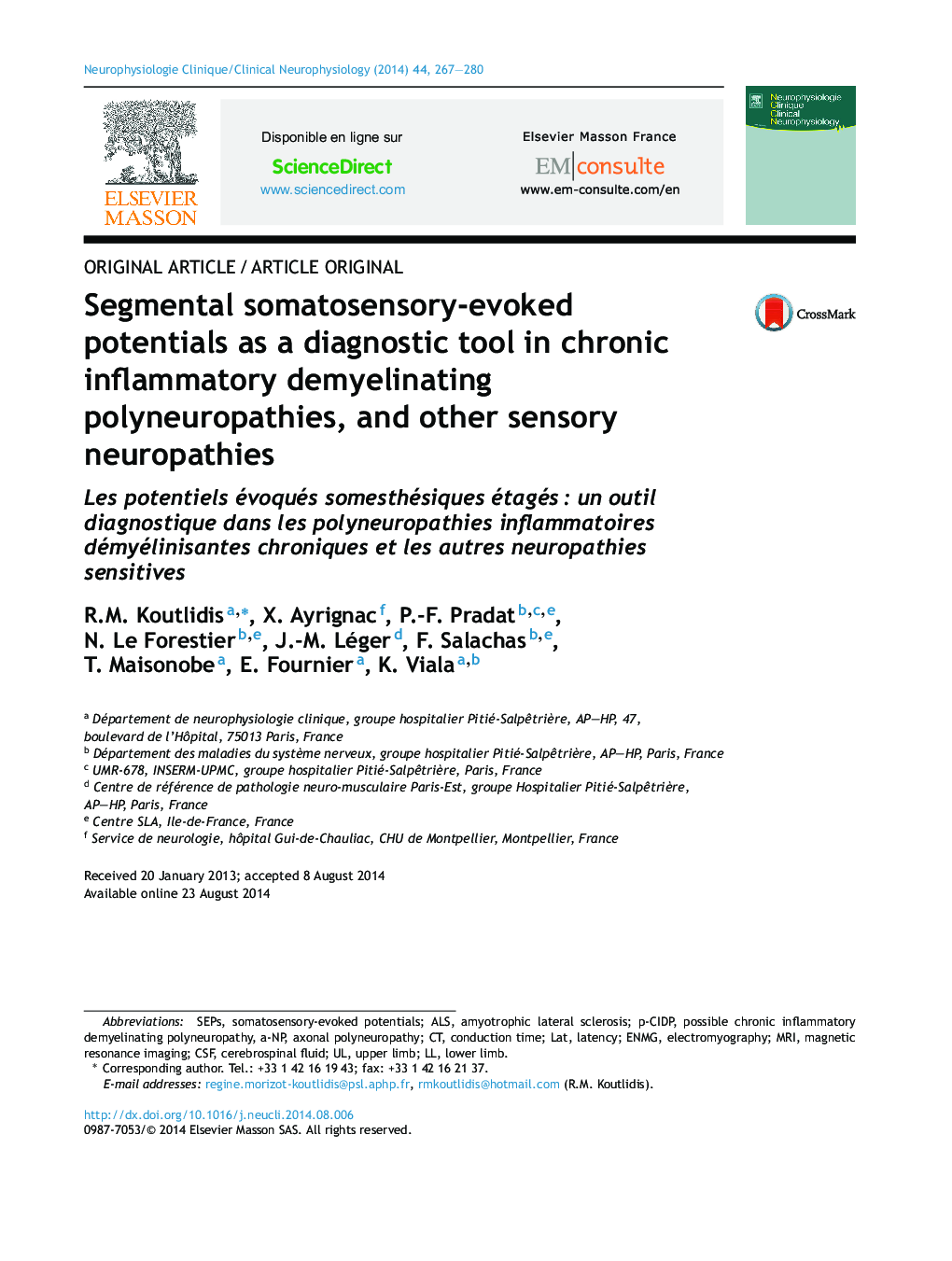| Article ID | Journal | Published Year | Pages | File Type |
|---|---|---|---|---|
| 3082146 | Neurophysiologie Clinique/Clinical Neurophysiology | 2014 | 14 Pages |
SummaryPurpose of the studySomatosensory-evoked potentials with segmental recordings were performed with the aim of distinguishing chronic inflammatory demyelinating polyneuropathy from other sensory neuropathies.Patients and methodsFour groups of 20 subjects each corresponded to patients with (1) possible sensory chronic inflammatory demyelinating polyneuropathy, (2) patients with sensory polyneuropathy of unknown origin, (3) patients with amyotrophic lateral sclerosis and (4) normal subjects. The patients selected for this study had preserved sensory potentials on electroneuromyogram and all waves were recordable in evoked potentials. Somatosensory-evoked potentials evaluations were carried out by stimulation of the posterior tibial nerve at the ankle, recording peripheral nerve potential in the popliteal fossa, radicular potential and spinal potential at the L4-L5 and T12 levels, and cortical at C’z, with determination of distal conduction time, proximal and radicular conduction time and central conduction time.ResultsIn the group of chronic inflammatory demyelinating polyneuropathy, 80% of patients had abnormal conduction in the N8-N22 segment and 95% had abnormal N18-N22 conduction time. In the group of neuropathies, distal conduction was abnormal in most cases, whereas 60% of patients had no proximal abnormality. None of the patients in the group of amyotrophic lateral sclerosis had an abnormal N18-N22 conduction time.ConclusionSomatosensory-evoked potentials with segmental recording can be used to distinguish between atypical sensory chronic inflammatory demyelinating polyneuropathy and other sensory neuropathies, at the early stage of the disease. Graphical representation of segmental conduction times provides a rapid and accurate visualization of the profile of each patient.
RésuméButL’étude des potentiels évoqués somesthésiques des membres inférieurs avec enregistrements périphériques étagés a été réalisée pour discriminer les polyradiculopathies inflammatoires démyélinisantes chroniques sensitives des autres neuropathies sensitives.Patients et méthodesQuatre groupes de 20 sujets ont été comparés : des patients atteints (1) de possible polyradiculopathie inflammatoire démyélinisante chronique sensitive, (2) de polyneuropathie sensitive axonale de diagnostic indéterminé, (3) de sclérose latérale amyotrophique et (4) des sujets contrôle. Les potentiels évoqués par la stimulation du nerf tibial postérieur à la cheville ont comporté l’enregistrement du potentiel de nerf au creux poplité N8, des potentiels radiculaire N18 (en L4-L5), médullaire N22 (en T12), et cortical P39 (en C’z), avec détermination des temps de conduction segmentaires. Les patients sélectionnés avaient des potentiels sensitifs conservés sur l’électroneuromyogramme et des ondes périphériques et médullaire en potentiels évoqués identifiables.RésultatsQuatre-vingt pour cent des patients du groupe des possibles polyradiculopathies inflammatoires démyélinisantes chroniques avaient des anomalies du temps de conduction N8-N22, et 95 % du temps de conduction N18-N22. Dans le groupe des polyneuropathies axonales, les anomalies prédominaient dans le segment distal, et 60 % des patients n’avaient aucune anomalie proximale. Aucun patient du groupe des scléroses latérales amyotrophiques n’avait d’anomalie du temps de conduction N18-N22.ConclusionLorsque les composantes périphériques sont identifiables, l’enregistrement des potentiels évoqués somesthésiques avec étude des temps de conduction périphérique étagée différencie les polyradiculopathies inflammatoires démyélinisantes chroniques atypiques des autres neuropathies sensitives. La représentation graphique proposée permet une visualisation rapide du profil de chaque patient.
